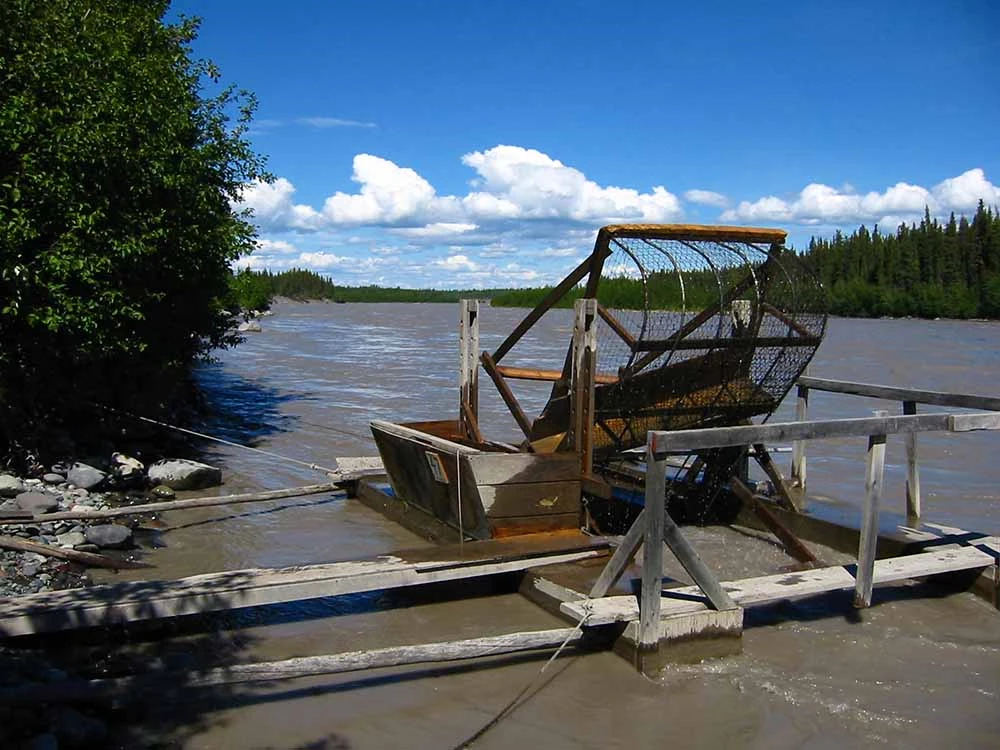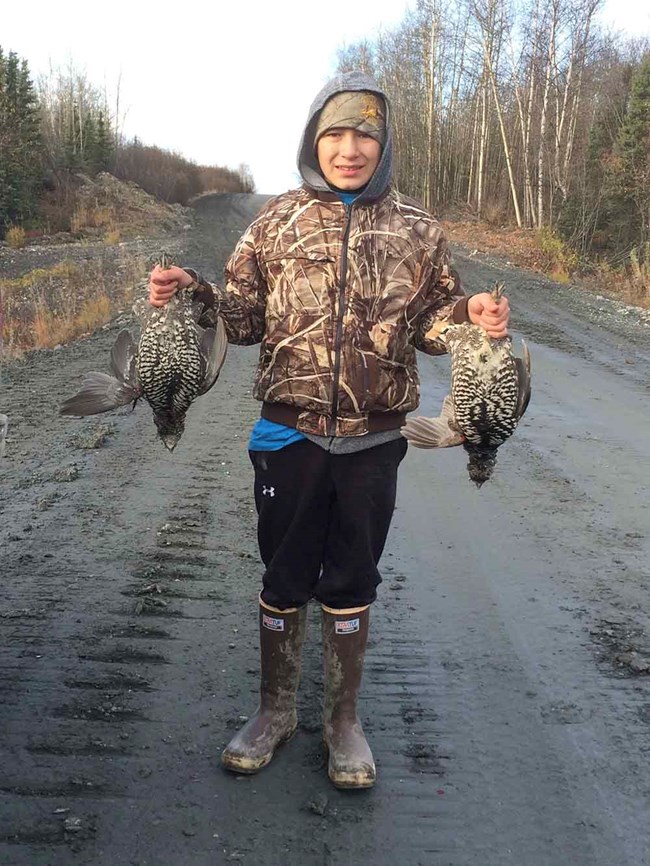Part of a series of articles titled Commemorating ANILCA at 40.
Article
ANILCA and Subsistence: Perspectives from a Former Federal Subsistence Board Chair
Mike Fleagle is an Interior Alaskan Iñupiaq raised in a subsistence lifestyle in the Tanana River community of Manley Hot Springs. He left Manley for a high school education in Fairbanks, followed by trade school in Anchorage. After working in the North Slope in Prudhoe Bay and the community of Barrow he relocated to McGrath where he raised his two sons, continuing the subsistence lifestyle and traditions he passed along to them. Mike has been an active participant in local area, regional and statewide civic opportunities; he served on both his village and regional ANCSA corporation boards for many years, Bean Ridge Corporation and Doyon, Ltd. He served as Chief of the Native Village of McGrath and was appointed to the Alaska Board of Game by two governors, Governor Knowles and Governor Murkowski. He served as chair of the Board of Game until being appointed to chair the Federal Subsistence Board in which capacity he served for four years. He is the only person to have served as chair of both the State and Federal regulatory boards.

NPS
As we celebrate the 40th anniversary of the Alaska National Interest Lands Conservation Act’s (ANILCA) passage into law, we are presented with an opportunity to reflect on a particular section of the Act, Title VIII—Subsistence Management and Use Findings, and its impacts on fish and wildlife management for Alaska’s rural subsistence users.
For millennia—or as many Tribal people prefer to say, since time immemorial—Indigenous Peoples have relied on the plentiful resources of the lands and waters of what would become known as Alaska for their sustenance, livelihoods, and cultural identity. While modern archeology and DNA analysis continue to investigate the arrival of Homo sapiens into the Americas, Alaska Native traditions generally say humans were created here and have always been here. This age-old (or infinite according to the Native perspective) dependence on natural resources for survival has been ingrained into the fibers of their persons and societies to the point of being the primary focus of their cultural identities at a deep spiritual level. According to this foundational tenet, to be Alaska Native is synonymous with being a subsistence user regardless of where they live.
The arrival of other ethnicities and cultures into Alaska through exploration, colonization, whaling, military activities, mining, fur trading, mission building, etc., introduced competition for Alaska’s wild resources. Control of Alaska by governmental entities, first by Russia, followed by the United States, and later the State of Alaska and its subsidiaries, brought about restrictions on traditional take of fish and wildlife with the implementation of new regulations. This made it even more difficult in many situations for Native people to find adequate resources or opportunities to fulfill their subsistence harvest needs. An unfortunate byproduct of this expansion and accompanying competition for resources, along with the establishment of more permanent communities that contributed to the discontinuation of nomadic lifestyles, was a higher reliance on missions, trading posts, military posts, and governmental assistance programs to satisfy basic needs, the latter of which continues to present itself often unfavorably today in many communities.
When Alaska joined the nation as its 49th state in 1959, one of the battle cries for statehood then was to “abolish the fish trap!” Under federal territorial management prior to statehood, many Alaskans felt oppressed in their ability to carry on subsistence harvesting while mismanagement or lack of management was occurring under the federal government’s watch. The statehood fish trap reference was in response to unrestrained, unsustainable fisheries occurring in some of Alaska’s rivers. Under Alaska’s control, management returned to a more local and perhaps more logical system (given the remoteness of Alaska to the United States Government) with the adoption of the new State Constitution. Article VIII of this document provides that its policy is to:
encourage…the development of its resources by making them available for maximum use consistent with the public interest (Sec. 1)
provide for the utilization, development, and conservation of all natural resources…for the maximum benefit of its people (Sec. 2)
wherever occurring in their natural state, fish, wildlife, and waters are reserved to the people for common use (Sec. 3) and
Fish, forests, wildlife, grasslands and all other replenishable resources…shall be utilized, developed, and maintained on the sustained yield principle, subject to preferences among beneficial uses. (Sec. 4)
With the new Constitution’s emphasis on “people,” “common use,” and “uses” over Indigenous Alaskans’ long-standing traditions of harvest, competition for resources continued to be an issue for many Alaska Native people. Because Alaska Natives had not been vanquished or relocated onto reservations by treaty as Native Americans had in the “Lower 48,” they maintained that they had continual rights to at least some portion of Alaska’s lands and waters, and importantly, accompanied by the aboriginal right to subsist without undue restriction on those lands and waters. Native claims were acknowledged, but determined not to be affected by Alaska’s statehood.

PHOTO COURTESY OF MIKE FLEAGLE
The 1971 passage of the Alaska Native Claims Settlement Act (ANCSA) attempted to settle the question of Native claims to land ownership through the establishment of 12 for-profit regional corporations and numerous village corporations who hold title to over 40 million acres of land on behalf of Native peoples along with a monetary settlement. A 13th landless corporation was also formed to settle monetarily with Alaska Natives who resided outside of Alaska in 1971. The question of protecting aboriginal subsistence rights was deferred to the State of Alaska and the Secretary of the Department of the Interior to settle later. In 1978, Alaska created a subsistence priority for all fish and wildlife uses, but failed to define “users,” which did nothing to protect Alaska Native subsistence rights, nor any other rural resident’s subsistence priority.
Despite the challenges Native people have faced in obtaining access to their traditional cultural practices of harvesting the natural resources they once relied upon largely without restriction, Native people nonetheless continued to practice subsistence harvesting and gathering where they could, often not in compliance with the published statutes or regulations governing said take. Most importantly, they kept the traditions alive and well among themselves and continued to pass the knowledge and practice along to subsequent generations.
I am a product of this generational passage of traditional cultural knowledge and practice, being of Inupiaq descent and having resided in Arctic or rural Interior Alaska communities for the majority of my life, living predominately off the land and waters and their fish and wildlife resources. As a child I was taught to harvest fish and small game to assist in feeding my family, and how to share in the bounty of those resources with other families. These traditions have been passed along to my children and grandchildren to carry on, hopefully in perpetuity.
ANILCA Title VIII made progress toward correcting deficiencies at the federal level in providing for Native subsistence opportunities, but still fell short of the goal to provide subsistence priority for all Alaska Natives, rather the law states that it applies to “subsistence uses by rural residents of Alaska, including both Natives and Non-Natives” (Sec. 801(1), emphasis added).
In the 40 years since ANILCA’s enactment, the State of Alaska adopted regulations to create a rural subsistence preference that were later determined to be unconstitutional by Alaska’s Supreme Court. Subsequently, the federal government began managing subsistence take on federal public lands and non-navigable waters. Management authority was later expanded to include navigable waters that are within, flow through, or are adjacent to federal lands. Attempts to bring a constitutional amendment to Alaska voters that would return a rural preference to all of Alaska have not been successful. Discussions that would add either a “rural Native only” (excluding non-Natives) or a “rural Native plus” (including non-rural Natives) clause have likewise failed to gain traction in appropriate fora.
Despite these challenges and shortcomings, Title VIII does provide some meaningful subsistence preferences for residents who live in rural communities that are within or near an applicable federal conservation unit and it also allows for the adoption of traditional practices not commonly accepted by state regulators.
The result to date is a contentious, complicated dual management system that Alaska appears to be destined to hold onto for the foreseeable future, creating disparity between those who have the ability to participate in subsistence activities on federal lands and waters and those who do not. ANILCA holds the key for future expansion of priority rights beyond the current legal and geographical constraints, but only if Alaska’s executive and legislative branches can work together to allow a constitutional amendment to be voted on by the people. Given the recent history of events, this may take a while.
References
Behnke, S. R. 1996.
How Alaska’s Subsistence Law is Working: Comparing Its Implementation Before and After 1992. A Report to the Alaska Department of Fish and Game Division of Subsistence.
Blackman, M. 1989.
Sadie Brower Neakok, An Iñupiaq Woman.
University of Washington Press.
Burch, Jr., E. S. 1998.
The Iñupiaq Eskimo Nations of Northwest Alaska.
University of Alaska Press.
Colt, S. 2002.
Salmon Fish Traps in Alaska: An Economic History Perspective.
Marshall, R. 1933.
Arctic Village. The Literary Guild.
Norris, F. 2002.
Alaska Subsistence: A National Park Service Management History. ISER Working Paper 2002.2. Alaska Support Office, National Park Service, U.S. Department of the Interior, Anchorage, Alaska.
Stuck, H. 1914.
Ten Thousand Miles with a Dog Sled. New York Scribner’s Sons.
Last updated: June 8, 2023
